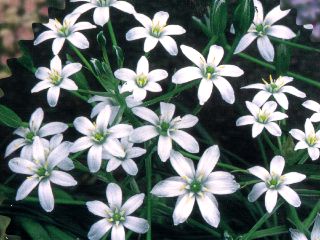
|
|
Star of Bethlehem - Ornithogalum umbellatum
|
Star of Bethlehem - (Ornithogalum)
Star of Bethlehem, (Ornithogalum
umbellatum) is a low, spring-blooming bulbous plant
of the family Liliaceae (lily family), native to the Mediterranean region but naturalized in North America and cultivated in
gardens. The plant has rather stiff, grasslike leaves and a cluster of white
star-shaped flowers marked on the back with green. It spreads easily and tends to become
weedy. Although the fresh plant is poisonous, the bulbs have been prepared and used as food in the Old
World. The flower has been associated with the star that guided the Wise Men to the manger
(Star of Bethlehem).
Ornithogalum umbellatum is an herbaceous plant that grows from bulbs that are renewed each
year. The bulbs are ovoid in shape and measure (0.5-1.5 in.) in length. The coat of the bulb is
membranous. The leaves are narrow and linear, measuring 10-30 cm (4-12 in.) long and 2-5 mm (0.1-0.2
in.) wide. The leaves form a tuft from which the scape emerges.
The white, star-shaped flowers are borne on a scape that can grow up to 30 cm (1
ft.) in height, but is usually shorter. The umbel-like raceme contains 3-10
flowers. Each flower has 6 petals and measures 1.5-2 cm (0.5-0.75 in.) in
diameter. The outside of the flower is green and white margined. The flowers appear on the plant from May to
June. The capsules of this plant are subglobose in shape and 3-sided. Each locule contains many black
seeds. Ornithogalum umbellatum disperses itself by means of its bulbs, which can be dispersed by
water.
Ornithogalum umbellatum is native to North Africa as well as Europe. In Europe, it is found from Portugal and Spain in the
west, south to
Italy and Greece, north to parts of France and east to Turkey.
Since this plant is still being used horticulturally, it is likely to continue spreading beyond its current
range. Ornithogalum umbellatum is poisonous if not lethal to livestock and should be prevented from spreading into agricultural
situations. Ornithogalum umbellatum produces new bulbs each year, and these bulbs are readily moved downstream to new
localities. It has the ability to form locally dense stands along the edges of the rivers and
streams, allowing it to crowd out native riparian plants.
Because it is toxic, Ornithogalum is not much browsed by wild animals, & all parts of the plant should be regarded as poisonous to people &
livestock. However, the bulbs are edible if they are either well-cooked, or dried &
powdered. They are sometimes eaten raw, but the possible dangers make that less than
wise. According to S. Facciola's Cornucopia: A Source Book of Edible Plants the blossoms have been used as an ingredient in baked bread &
pastries.
Extracts are used by herbalists for treatment of fearfulness, suicidal
depression, or grief, as well as for ulcers, flatulence, & such serious diseases as
cancer.
Star of Bethlehem is one of the five flowers in the rescue
remedy. This essence is a restorative remedy for calming anyone who has experienced shock or
trauma. It has a balancing energy that is helpful in taking while undergoing counseling or therapeutic healing
periods. Aids the grief process.
The name Star of Bethlehem is mainly in allusion to the six-pointed blooms, but may also have come about because it was used as a famine food by medieval pilgrims to the Holy Land & was to be found growing all around
Bethelehem, perhaps planted there by the Christian pilgrims. It was known in Europe in an earlier time as Dog's
Onion, but by the 15th Century it became associated with pilgrims & so came to be called
Star-of-Bethelehem.
By a curious coincidence, the Greek name which is preserved in the modern Scientific genus name was
"Bird's Milk," & is called Bird's Milk in several languages. The term Bird's Milk is synonymous with
"a wondrous thing," but originally alluded to an ancient belief that doves were of a single sex
(females) & from the large breasts of the dove they were able to give milk,
mammal-like, to their young. The Dove was throughout the mid & near east believed once to have been a Star that descended to the world as a benefactor to
humanity, so that both the Star & the Dove symbolized such goddesses as
Ishtar, Aphrodite, & Cybele. When in Aristophanes' Lysistrata Pithetaerus
says, " I will make you a king and will feed you on bird's milk & honey," he speaks of milk of a
Goddess-bird that dwells upon Olympus.
Source:
http://www.bartleby.com/65/st/starBeth.html
http://webapps.lib.uconn.edu/ipane/browsing.cfm?descriptionid=82
http://www.paghat.com/sleepydick.html
